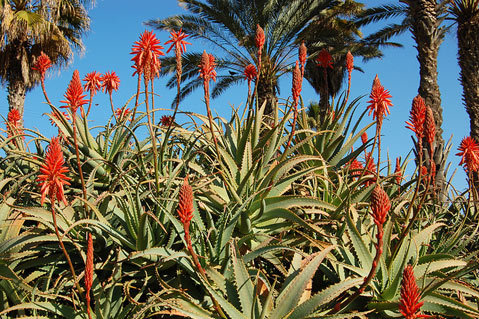Winter Succulents
Aloes are Blooming

Everybody must know by now that the main blooming season of the aloes in our Southern California landscape is winter. Thousands of fleshy spires are emerging from their green rosettes of leaves, and soon the millions of tubular flowers that they support will begin to color and open. Most are in glorious shades of dark orange, although yellow and deep rose does appear, as well. While there are hundreds of species of aloes and more and more are being introduced to horticulture here, the showiest ones around town are Aloe arborescens and a natural hybrid between A. wickensii and A. ferox known as A. salm-dyckiana. Less conspicuous are the clambering A. ciliaris and the tidy A. striata.
Another winter wonder is Agave attenuata, the foxtail agave. The lusciously soft and broad leaves are pedestrian- and gardener-friendly and so have found a place not only in personal gardens, but in many municipal situations, as well. The sinuous spires that rise in early winter to carry the pale ivory flowers are clothed in narrow leafy bracts that look like an upswept hairdo. Long before the first flowers open at the base of the spike, it has elongated to 4 feet or so, and the tip has assumed a graceful nod. The mass plantings along Alameda Padre Serra east of the Riviera complex are not to be missed, even with the few casualties that reached too far into the traffic zone.
A few of the other agaves get the urge to procreate this late in the year, too. A. americana is among the largest agaves planted hereabouts. Its formidable leaves can be 6 feet long, and the overall rosette, more than 10 feet wide. But when it blooms is when it really inspires awe. The central flower stalk looks like a monster asparagus spear, growing skyward at the rate of several to many inches a day, depending on the weather. Finally, it achieves its ultimate height 20 to even 40 feet and sends out radiating branches supporting large, greenish white flowers. This agave evolved to provide copious nectar to attract the bat pollinators in their native habitats. Modern bees and adventitious crows have learned to reap those rewards.
These hardy plants have survived the long, dry season by sequestering their precious moisture within the spongy tissue of their leaves and the stems hidden within their rosettes. Once the threat of summer heat is gone and a providential rain has fallen, they go into action. Roots efficiently and quickly harvest the new moisture, transferring it to the plant body, triggering that urge to bloom. For the aloes, this is just a part of the annual routine, and once the flowers have faded (and seeds have been shed), the plant continues to increase in size or stature for another year.
Agaves are significantly different. This is a once-in-a-lifetime event for them. For years, the leaves grow and photosynthesize, building up reserves of food within the enlarging stem. What the exact cue is for them to burst into reproductive frenzy on any given year is only partially understood, but the result is a sacrificial exertion that literally saps the plant’s resources to produce the next generation. “Century” plants don’t actually live one hundred years before completing this cycle, but many may live for several decades before they fulfill their ultimate destiny—to our wonderment.
December Tips
• Adjust irrigation systems. Probe the soil to see if it really is moist from the intermittent rains.
• Winter is the time to prune trees that are susceptible to beetle damage such as pines and eucalyptus. Cover the wood tightly to keep beetles from escaping, or chip the wood as you prune.
• Bring your living Christmas tree in for 10 days or less, and keep it away from heaters and fireplaces.



